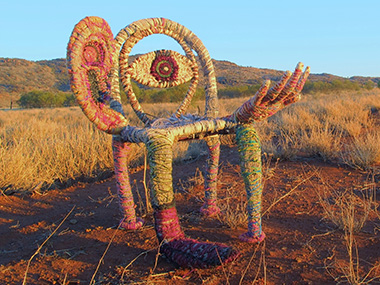A MESSAGE FOR MALCOLM?

Pitja, nyawa, kulila (come, look, listen), 2015, by Anawari Mitchell, Jennifer Mitchell, Elaine Lane, Nora Davidson and Janet Forbes. Photo by Vicki Bosisto, ©Tjanpi Desert Weavers, NPY Women’s Council.
Posted by Jeremy Eccles | 16.09.15
Gallery: Araluen Centre for Arts and Entertainment
Dates:
01.09.15
: 03.09.15
“This chair is a special chair. This chair tells a story. We the women of the Ngannyatjarra Lands invite the Government people to come here and to sit down with us. Use your eyes and look around. Open your ears and listen to us. This chair is made of grass and feathers from this country. The women are represented by the round ones on the feet of the chair. The invitation is to stand with us, and to help us. We are working hard for our families and we need your helping hand”
Tjanpi (pronounced, Dumpi and meaning ‘grass’) evolved from a series of basket weaving workshops held on remote communities in the Western Desert by the Ngaanyatjarra Pitjantjatjara Yankunytjatjara Women’s Council in 1995. Tjanpi sculptures were first produced in 1998 when Kantjupayi Benson, from Papulankutja, added a handle to a basket and made a grass ‘pannikin’ (metal cup) followed by a set of camp crockery and a number of dogs. By 2005, the ladies from Blackstone/Papulankutja had developed their confidence and techniques sufficient to win the 'Big Telstra' for their 'Tjanpi Toyota'. Now the angst welling up in remote communities as former PM Abbott talked about their “life-style choices” to live in remote deserts and WA Premier Barnett threatened to close down any that didn't make economic sense to him has lead these crafty women into politics.
Reading these concerns into the Tjanpi Chair - Pitja nyawa kulila (come, look, listen), 2015 - collector (and grazier) Matt Dixon described the work, seen this month at Desert Mob in Alice Springs, as “one of the most dramatic and important pieces of art made in the past decade - mind-blowing”.
One of the artists, Anawari Mitchell told him, “I got the chair – it was old and broken and lying around – and I said, 'I'm gonna do this chair – try to do something with it, something different. With the other women, we gave it hands out, asking; ears to listen; and eyes to see what's going on”.
Anangu women of the Central and Western Desert have for a very long time worked with natural fibres to create items such as bush sandals (wipiya tjina), pouches (yakutja), hair-string skirts (mawulyarri), and head-rings (manguri) for daily and ceremonial use. Adding a contemporary spin to the traditional, women now create baskets, vessels and an astonishing array of vibrant sculptures from locally collected desert grasses bound with string, wool or raffia and often incorporating feathers, seeds and found materials.
The Chair was snapped up by a collector on the first day of Desert Mob, but the Tjanpi Weavers organisation hopes to be able to exhibit it on loan from him.
URL: http://www.artsandmuseums.nt.gov.au/araluen-cultural-precinct/araluen/desertmob_exhibition
Share this:
»  del.icio.us
»
del.icio.us
»  Digg it
»
Digg it
»  reddit
»
reddit
»  Google
»
Google
»  StumbleUpon
»
StumbleUpon
»  Technorati
»
Technorati
»  Facebook
Facebook
Contact Details
Gallery: Araluen Centre for Arts and Entertainment
Email: araluencentre.dom@nt.gov.au
Telephone: +61 8 8951 1120
Address: Larapinta Drive or PO Box 3521 Alice Springs NT 0871 Alice Springs Alice Springs 0870 NT
Gallery: Araluen Centre for Arts and Entertainment
Email: araluencentre.dom@nt.gov.au
Telephone: +61 8 8951 1120
Address: Larapinta Drive or PO Box 3521 Alice Springs NT 0871 Alice Springs Alice Springs 0870 NT
Where is the exhibition?
Further Research
Gallery: Araluen Centre for Arts and Entertainment
Artists: Anawari Mitchell | Elaine Lane | Janet Forbes | Jennifer Mitchell | Kantjupayi Benson | Nora Davidson
News Tags: Desert Mob | Jeremy Eccles | Malcolm Turnbull | NPY Womens Council | Telstra Prize | Tjanpi Toyota | Tjanpi Weavers
News Categories: Art Fair | Australia | Blog | Event | Exhibition | Feature | Industry | News
Exhibition Archive
- 10.10.17 | TARNANTHI 2017
- 11.08.17 | Natsiaas 2017
- 20.07.17 | APY ART DOMINATES THE WYNNE
- 17.07.17 | Anangu Artist Wins $100,000 Prize
- 14.07.17 | The End of AAMU
- 11.07.17 | ART ACROSS THE COUNTRY
- 11.07.17 | TARNANTHI IN OCTOBER
- 05.07.17 | TJUNGUṈUTJA - from having come together
- 13.06.17 | Ghost-Nets Straddle the World
- 07.06.17 | Grayson Perry Going Indigenous?
- 05.06.17 | Barks Bigger than Ben Hur
- 27.05.17 | NGA QUINQUENNIAL 2017
- 21.05.17 | Blak Douglas Finds Home at the NGA
- 21.05.17 | BRIAN ROBINSON WINS HAZELHURST WOP
- 18.05.17 | PARRTJIMA 2.0
Advertising

